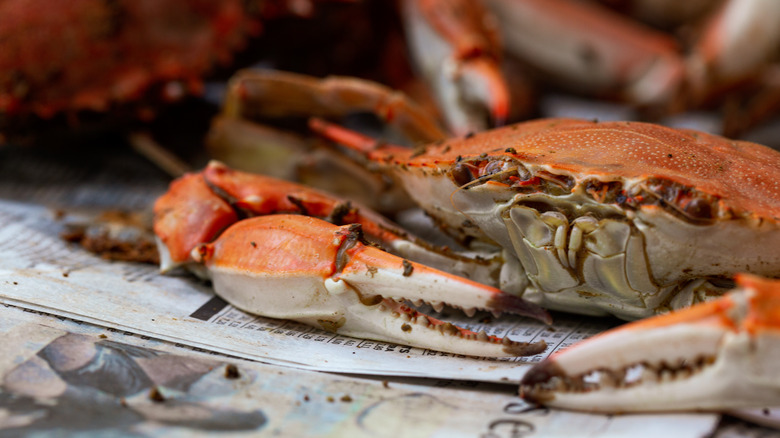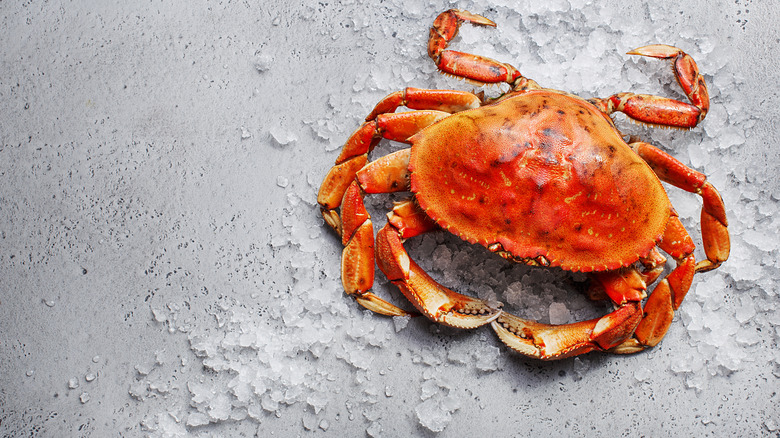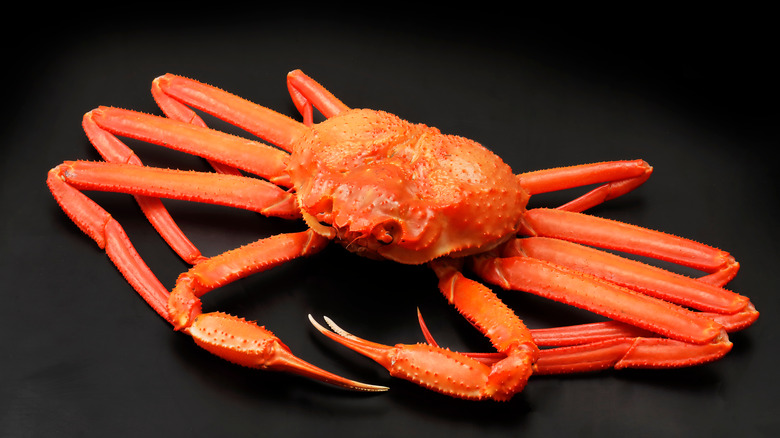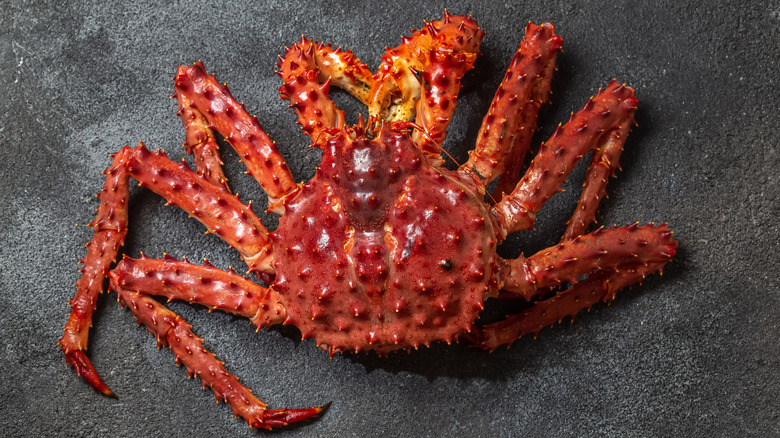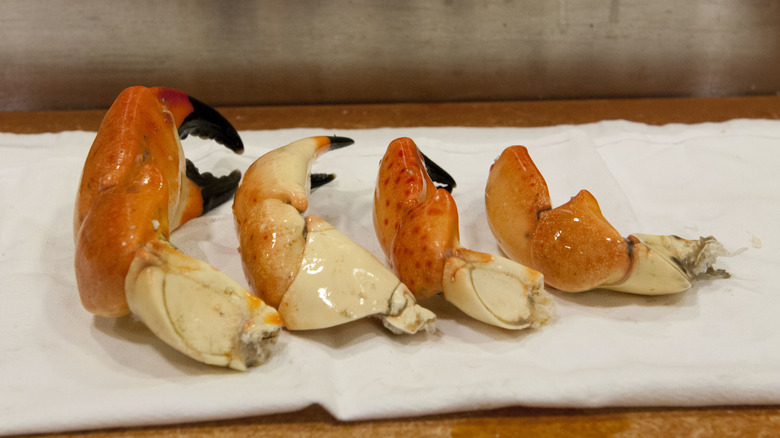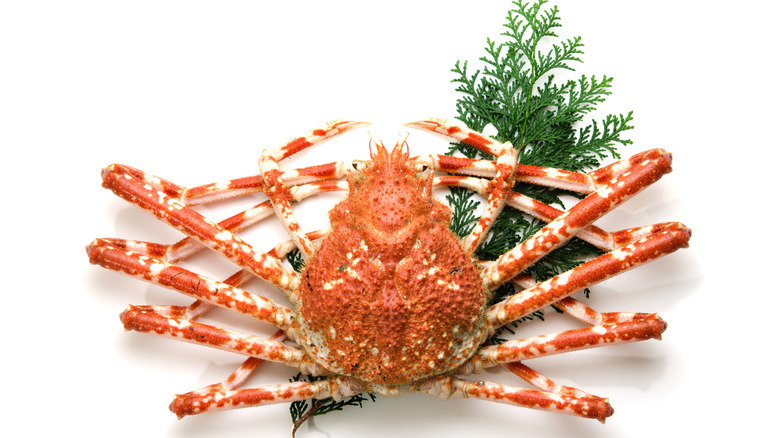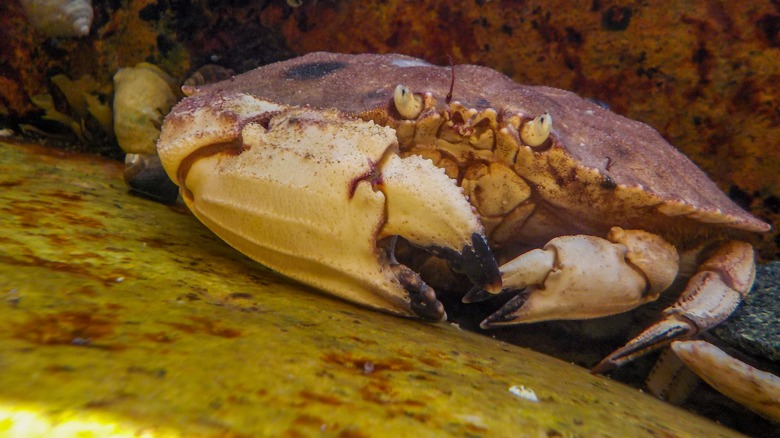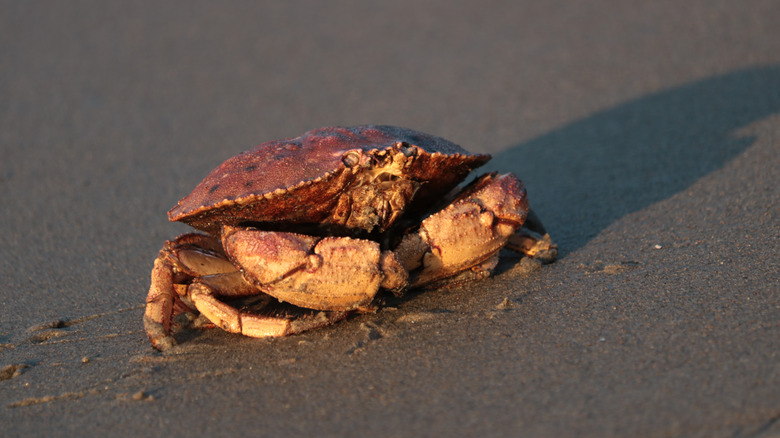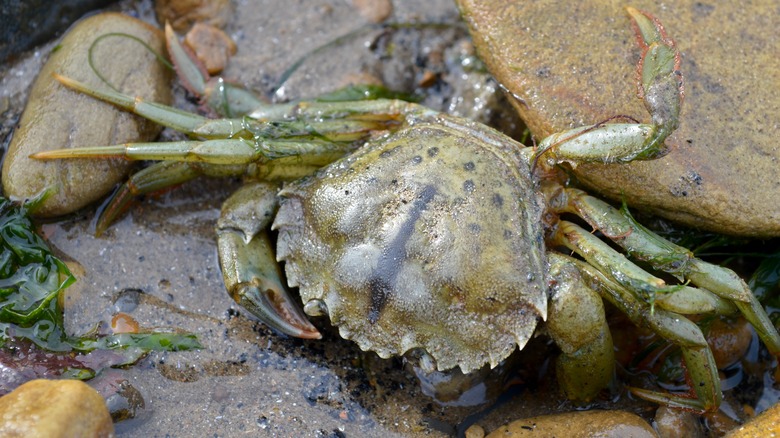9 Types Of Crab And How To Cook With Them
Among the many treasures the sea has bestowed upon us, few are as extraordinarily sweet and enjoyable as the crab. Neanderthals dined on brown crabs nearly 90,000 years ago, leaving charred shells and claws as their ancient testimony; we, too, can't get enough of the succulent meat hidden within those armored shells. Whether the Atlantic blue crab, known for its distinctively blue shell, or the West Coast celebrity, the Dungeness crab, prized for its sweet, flaky meat, crabs have undoubtedly become the quintessential shellfish of America.
Not only will you find one of the greatest abundance of crabs in the world (local and imported) here in the U.S., but crabs that once were strictly regional have transcended coastal barriers and are now available in the seafood markets across the country. You can easily pick a stone crab for a smooth and creamy bisque in LA or make a buttery crab cake from the Pacific rock crab in Florida.
If you've never cooked a live crab before, their monstrous claws may seem intimidating at first, but there's no need to fret — the claws contain some of the best crab meat. So, when you finally feel ready to look a crab in the eye before plunging it into the boiling water, we've put together a list of all the essential crabs you should know, with a handy guide for tackling each. And don't worry — you don't always have to cook them live.
1. Blue crab
Blue crabs are a common sight along the Atlantic coast of North America, stretching from Nova Scotia down to Argentina, but nowhere are they as popular as Chesapeake Bay. These medium-sized crustaceans can grow up to 9 inches in size, not including the legs. They have a tough shell, typically dark blue to olive green on top and white on the bottom, and have easy-to-recognize blue claws with red tips.
While cooked or canned blue crab is easy to find in the supermarkets, live crabs are an exceptional treat worth hunting for — just remember you'll have to keep them alive before they're ready for the simmering pot. To cook a fresh blue crab, start by removing all the dirt and debris. You can freeze them for 15 minutes or stun them with a mallet for the most humane way to cook them. Boil them in water for about 10 minutes per pound or until they turn red and float to the surface. Once cooked, open them and extract the meat with a crab cracker, fork, or pick. It's best to skip the gills as they may contain toxins and other pollutants like microplastics.
There are many ways to use the crab meat. Whipping up a she-crab soup is a soothing choice. It's a beautifully creamy and flavorful soup usually made with heavy cream (or milk), butter, onions, celery, crab roe, and spiced with some bay leaf and nutmeg. For a lively kick, you could also add a touch of Worcestershire sauce.
2. Dungeness crab
If you're looking for a sweet, succulent crab, the Dungeness crab is an excellent one to pick. This Pacific Northwest delicacy inhabits eelgrass beds and muddy bottoms along the west coast of North America, from Alaska to California, sometimes as far south as Mexico. They can grow up to 8 inches in size and weigh up to 2 pounds. Dungeness crabs are named after the Dungeness Spit, a wildlife refuge outside Washington where you can find an abundance of these popular crustaceans.
Once you've bought live Dungeness crabs, the first step is to cook them by boiling or steaming. After cooking, remove the top shell and the gills — these are often unappealingly known as "dead man's fingers." You also want to get rid of the yellow substance, known as crab "butter" or tomalley, found in the body cavity. Once ready, rinse the crab thoroughly and break it into sections for serving.
Oven-roasting your Dungeness crab is another simple yet effective technique to bring out the natural sweetness of the crab. Season the crab with herby garlic butter and then roast it in a hot oven for around 15 minutes. You could crack into it and enjoy it as it is, or toss it with olive oil, butter, garlic, white wine, or crème fraîche for an elegant linguine pasta.
3. Snow crab
Snow crab is found in the cold waters of the Northwest Atlantic and North Pacific oceans. Snow crab is slightly smaller than another popular choice, the king crab, and is sometimes called the "queen crab." These crabs have long legs and thin shells that are easy to crack open, giving way to sweet, mild, and slightly briny meat that tastes similar to lobster. The legs and claws of snow crabs are the most meaty and are considered the best parts of the crab to eat.
To enjoy snow crab legs, start by rinsing them under cold water. Steam the legs over boiling water for approximately 5 minutes or until the meat turns pink. Alternatively, you can dip it in salted water and boil it for about 10 minutes. Breaking the shells and pulling out the meat can be done using your hands or a specially-made crab cracker (although a nutcracker will do). Serve with a garlic butter dip and a lemon wedge, or try it with garlic aioli — snow crab is excellent in zesty citrus salads as well.
You can find snow crab legs fresh or frozen year-round, with the peak season running from January to April in Alaska and from April to August in Canada. When choosing your snow crab, look for bright red clusters of legs that are firm and free of any signs of freezer burn or discoloration.
4. King crab
The king crabs are famous for their undeniable grandeur and exceptional meat. Some specimens have been known to reach up to 6 feet in leg span and weigh up to 24 pounds, placing them among some of the largest crustaceans on the planet. King crabs are mostly found in the chilly waters of the Bering Sea and Gulf of Alaska, where the conditions are so extreme that fishermen sometimes risk their lives catching them.
Aside from their impressive size, king crabs have distinctively long, spiny legs carrying their enormous bodies and fan-shaped tails tucked underneath. You will likely stumble across three popular varieties of king crab: Red, blue, and golden. The blue and the golden king crab are the milder, entry-level varieties, while the red king crab is the most sought-after for its succulent white meat with hints of brininess. However, be prepared to splash out for their delicate flavor as the decline in crab populations and the closures of fisheries continue to drive their price higher.
When shopping for king crab, the leg and claw meat is what you're after. Whether steaming, boiling, or grilling, the delicate and flaky king crab meat makes a beautiful dip or goes very nicely in a salad. However, nothing beats cracking into the whole leg and dipping the meat into creamy garlic butter with some lemon and parsley.
5. Florida stone crab
The Florida stone crab is commonly found along the west coast of the North Atlantic, Gulf of Mexico, and Caribbean Sea and has large black-tipped claws that can grow up to 5 inches long. These claws are the only edible part of the crab and are harvested by breaking them off the live crab. Once the claws are removed, the crab is returned to the water, where it continues to live and, if all goes to plan, regenerate new claws.
Most stone crab claws in the US come from Florida fisheries and are the best from October to May during their peak season. The meat has a mildly sweet flavor that will not overshadow other ingredients. Boiling is the quickest way to cook stone crab claws, but if you're after something more fragrant, try steaming them with garlic, bay leaves, and thyme sprigs. Crack and serve with some whipped herby butter.
Stone crab claws can also be cooked in a pan. Heat some olive oil in a large skillet over medium-high heat with minced garlic and pepper flakes. Then, add white wine, lemon juice, capers, salt, and pepper, and bring to a boil. Reduce the heat to a simmer and cook for around 15 minutes or until the sauce slightly reduces. Add the claws and toss to coat, cooking for another 5 minutes or until they are heated through. Garnish with a little chopped parsley, and don't forget some crusty bread on the side.
6. Japanese spider crab
The Japanese spider crab lives in the waters off the coast of Japan, stretching as far south as Taiwan. This remarkable creature has a legspan of up to 12.5 feet measured from tip to tip, a stunning orange and white marbled top shell, and a cream belly. Its long spider-like legs are its most distinctive feature, but don't let it scare you: The Japanese spider crab has a delicate, sweet flavor that's a real treat in sandwiches, poke bowls, or just enjoyed with a little lemony butter.
It's not a crab you will find easily in North America, but if you hop into the specialty Japanese seafood market, you will likely notice one of these monsters. If you're keen to cook the spider crab, the most humane way to kill it is to be firm and decisive. First, flip it upside down and stab it through the center with a knife. Then you can simply boil a large pot of salted water and cook it for 12 minutes per kilo of the crab.
Finally, rinse the crab, let it cool, and pull apart the legs, claws, and body. Scrape out the brown meat from the body and remove the pointed gills. To open the legs, wrap each leg and claw in a tea towel and cack them gently with a mallet. The brown meat from the body is edible, but it has a richer, more fatty flavor.
7. Jonah crab
Jonah crab is a New England favorite found on the Atlantic coast of North America and Canada, right down to Florida. It has a distinctive round, rough-edged shell dotted with light spots, and large claws with dark tips. The average Jonah crab measures 4 to 5 inches across its carapace, but some can reach up to 9 inches. The claws, packed with succulent meat, are often sold separately.
It takes around six minutes to boil a whole Jonah crab, but you can also grill it for a few minutes to give a lightly smoky flavor. To crack the shell of the crab, pick any handy tool like a nutcracker, a mallet, or a knife. The claws have plenty of meat inside, but check the body and legs for extra bits.
The meat of the Jonah crab is flaky, with a mildly sweet, briny flavor. The texture is similar to Dungeness crab but more dense. You can enjoy it plain or serve it with some melted butter, lemon juice, or a tangy mustard sauce to complement its sweetness. Whisking a creamy wine sauce with garlic would be a chef's kiss for the subtle flavor of this crab.
8. Atlantic rock crab
Atlantic rock crab is a small but flavorful crustacean living all along North America's east coast, from Canada down to Miami. It can grow up to five inches across and has a smooth, oval-shaped carapace that ranges in color from yellowish-brown to reddish-purple. Rock crab used to often be dismissed as a pest by fishermen, for eating the bait from their lobster traps. Thanks to the efforts of some innovative chefs, however, who gave it the catchy name of peekytoe (a Maine term for "picked toe" or "pointed toe"), this crab has become a prized delicacy in the culinary world.
Live rock crabs do not ship well, so their sweet, juicy meat is usually packed and cooked at the source. However, if you happen to stumble upon live peekytoe crabs, there are several ways to cook them, such as steaming, grilling, roasting, or boiling. Once cooked, crack open the claws and legs to extract the tastiest parts. Making crab cakes is one of the best ways to enjoy Atlantic rock crab. Mix the crab meat with mayonnaise, Dijon mustard, parsley, Old Bay seasoning, bread crumbs, and egg to form patties. Then, fry them in oil until they turn golden and crispy on both sides. Serve it with your favorite version of remoulade sauce.
9. European green crab
The European green crab is an invasive species established along the coasts of California, Oregon, Washington, and British Columbia. These crabs, originally from Europe and Northern Africa, can thrive in a range of temperatures and salinities, which makes them real globe-trotters of the crab world. Their coloring varies with age, from green to yellow and even orange, but the telltale sign is the five spines on either side of their eyestalks.
Cooking green crab is an excellent opportunity for you to step up to the plate (quite literally) and help manage the population of this intruder. Once your green crabs are cleaned from sand and mud, boil them in water for 5-7 minutes until red. Remove the carapace, scoop out the roe and crab mustard, and set them aside. Pull back the apron gently to reveal the intestine and discard it while preserving any roe. Use a knife to divide the body into four sections, extracting the meat between the cartilage. Use a nut or lobster cracker to gently crack the claws — watch for tiny shell fragments!
There are many recipes for you to try with this tiny crustacean: Green crab stock can become the secret behind a savory punch in your soups or sauces, while a spicy green crab curry is a sure way to turn up the heat in your kitchen. Before you head out to catch any, however, check your local guidelines and, if you need to, get a shellfish license.
